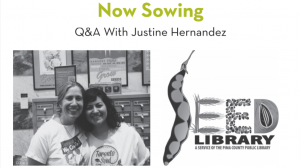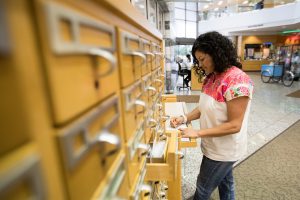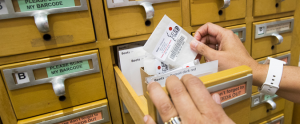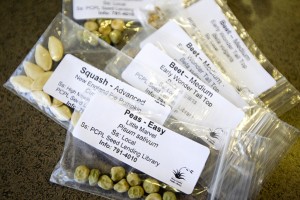 This article originally appeared in Conspiracy News, Winter 2017 New Year, New Growth Edition
This article originally appeared in Conspiracy News, Winter 2017 New Year, New Growth Edition
In the next issue of Conspiracy News, we’ll be launching our media partnership with the Pima County Public Library’s Seed Library. Whether you’re a lifelong seed geek or a budding gardener, you’ll have the opportunity to learn from true seed experts in each issue of Conspiracy News. For more information about their important work, read our Q&A with seed librarian Justine Hernandez.
FC: Tell us about the Seed Library!

JH: The Pima County Public Library’s Seed Library (and seed libraries in general) is one of the most beautiful and powerful modern day expressions of community, generosity, hope, and resiliency. The Seed Library is a community supported stock of open-pollinated and heirloom seeds that anyone with a Pima County Public Library card can borrow and plant. Ideally, Seed Library borrowers will enjoy fruitful garden harvests from the seeds they plant. But we also hope gardeners will leave some of the plants in their gardens to mature even further, allowing them to go to seed. Then they can be collected and shared back with the Seed Library for future gardeners to plant. This continues the cycle of borrow, grow, and share.
The Seed Library’s vision is for a connected community that has the power to grow healthy. And our mission is to provide equitable access to seeds, knowledge, and opportunities. For us, this means we are working toward engendering a community of gardeners and seed savers who are contributing to a community sustained and regionally adapted seed stock. We want to our community to feel connected to one another through this act of sharing. We want the gardening and seed saving actions of our community members to feed their understanding of our current food system and empower them to be engaged in shaping it for the future.
FC: When was the Seed Library established? How did it happen?
 JH: The Seed Library was established in January of 2012 and was largely motivated by the lack of access to fresh foods for many living in our community, as well as the unsustainability of our modern day food system. We took our inspiration from the Community Food Bank’s Santa Cruz River Farmers’ Market, which was helping to increase access to affordable, fresh, locally grown, nutritious food. The market was also connected to other CFB programs, going a step further to empower a healthier, more equitable food system by connecting people to the tools, knowledge and support to nourish themselves and their communities. Public libraries are “the commons” of our society, and are likewise in the business of enriching lives. They’re archives of our community’s collective knowledge and creativity, held in trust for everyone’s access and benefit. More recently, libraries have also become hubs for creation, connection, and sharing. So it seemed a reasonable fit for the library to create space for connecting our community to something as lovely and as empowering as the stewardship of our agricultural heritage.
JH: The Seed Library was established in January of 2012 and was largely motivated by the lack of access to fresh foods for many living in our community, as well as the unsustainability of our modern day food system. We took our inspiration from the Community Food Bank’s Santa Cruz River Farmers’ Market, which was helping to increase access to affordable, fresh, locally grown, nutritious food. The market was also connected to other CFB programs, going a step further to empower a healthier, more equitable food system by connecting people to the tools, knowledge and support to nourish themselves and their communities. Public libraries are “the commons” of our society, and are likewise in the business of enriching lives. They’re archives of our community’s collective knowledge and creativity, held in trust for everyone’s access and benefit. More recently, libraries have also become hubs for creation, connection, and sharing. So it seemed a reasonable fit for the library to create space for connecting our community to something as lovely and as empowering as the stewardship of our agricultural heritage.
FC: What types of seeds are stored in the seed library?
JH: Gardeners will find several familiar varieties of open-pollinated (not hybrid) and heirloom food crop and decorative plant seeds in the Seed Library’s drawers, but they’ll also find many more less common varieties that represent the incredible diversity that has gone missing from our modern day produce aisles (and that collectively we can help restore). You can find varieties with names that often reflect early stewards and geographies, like the local favorite, Mrs. Burns’ Famous Lemon Basil, named after the mother of Native Seeds/SEARCH founder, Barney Burns, or the tasty and exotic Indonesian Kennikura Cosmos. The biggest misconception about the Seed Library is that all of the seeds in our drawers are native seeds. There are several varieties of native species, especially native pollinator species, but many of our initial “starter” seeds are open-pollinated and heirloom varieties that have been generously donated by out-of-state seed companies, such as Baker Creek or Seed Savers Exchange. Our collective job as a community of gardeners and seed savers is to create hardy, desert adapted, local seed stock from these seeds through the continual process of planting and saving our seeds.
FC: How can Tucsonans use the seed library? What type of assistance is provided by the seed librarians?
 JH: Anyone with a Pima County Public Library card can check out up to 10 packets of seeds each month. People can stop into any one of the 8 branch locations that house the actual seeds to browse through the drawers of seeds, or they can search the library’s online catalog and place seeds on reserve to be sent to their local branch for later pick-up. Seeds are arranged alphabetically by common name, so you’d search the “B” drawers for bean varieties and “C” drawers for chard varieties. The seeds are also categorized by “easy” and “advanced,” which refers to what level of seed saving knowledge and skill is involved in successfully saving seed from that variety. Easy seeds are from plants that are self-pollinated, whereas advanced seeds are from plants whose pollination needs are met through crossing pollen from one flower to another. Many of the favorite crops of beginner gardeners also happen to be easy-to-save seed, such as lettuce, tomatoes, and beans.
JH: Anyone with a Pima County Public Library card can check out up to 10 packets of seeds each month. People can stop into any one of the 8 branch locations that house the actual seeds to browse through the drawers of seeds, or they can search the library’s online catalog and place seeds on reserve to be sent to their local branch for later pick-up. Seeds are arranged alphabetically by common name, so you’d search the “B” drawers for bean varieties and “C” drawers for chard varieties. The seeds are also categorized by “easy” and “advanced,” which refers to what level of seed saving knowledge and skill is involved in successfully saving seed from that variety. Easy seeds are from plants that are self-pollinated, whereas advanced seeds are from plants whose pollination needs are met through crossing pollen from one flower to another. Many of the favorite crops of beginner gardeners also happen to be easy-to-save seed, such as lettuce, tomatoes, and beans.
Even for the more seasoned gardeners, seed saving definitely presents a steep learning curve. We want to be sure that the seeds our gardeners are saving and sharing back to the community are properly saved and healthy. That said, we encourage gardeners to plant the seeds from the Seed Library and spend some time in their gardens observing, learning, and cultivating their understanding of their garden’s life-cycle before trying to save seed right away. Of course, the Seed Library will only continue to exist through the community’s seed saving efforts, which is why we encourage everyone who takes part in planting from the Seed Library to set a goal to eventually become contributing seed savers.
It makes sense that we need to allow ourselves to learn to garden before becoming seed savers, so we’ve directed a lot of our energies toward helping people grow as gardeners. We’ve built up a pretty hearty collection of gardening books with an emphasis on organic and desert gardening (when available). We also work with Master Gardeners, local garden experts, and on their “off” season, the Community Food Bank, to offer a range of gardening programs throughout the library system. We also offer seed saving classes throughout the year, but most energies up until now have largely gone toward basic gardening.
Because we’re such a large library system (27 branches) and seeds can be picked-up at any one of the branch libraries, the Seed Library Team has devoted a lot of time creating online resources for guiding borrowers to what’s ready to sow, how to plant it, and what to consider if they’re thinking about saving seeds from their crop. Gardeners can also find printed versions of our “now sowing” guides at any of the 8 Seed Library locations. I recommend that everyone spend some time browsing our webpage. It’s chock-full of great information!
FC: What do you love the most about being a seed librarian?
JH: Mostly I love that I get to be a part of revealing the big heart of our community. I am such a believer in the generosity and kindness of human beings, and I want to help create opportunities for us to act on our nature. I want the library to be a part of cultivating that through seed sharing.
FC: Can you share an inspiring "success" story from a home gardener or budding seed saver?
JH: For me, the success story really is our community’s story. Several days a week, we arrive at work to find seedy offerings spilling out of our Seed Library cubby. Even though roughly half of what’s shared is destined for the “seedball” mystery mix, my seed librarian sisters and I do a little happy dance in celebration of people’s generosity and willingness to participate in this community-wide adventure (though it’s not lost on us how important continued education is to turn enthusiasm into long-term success and sustainability). Roughly 35 percent of the seeds that are in the Seed Library’s collection are of locally saved seed stock—that’s pretty significant! I’d call that a terrific success.

